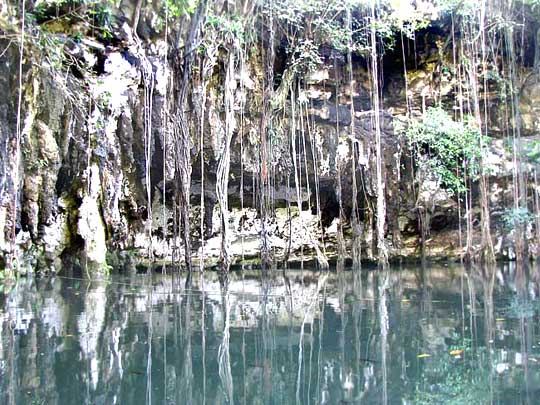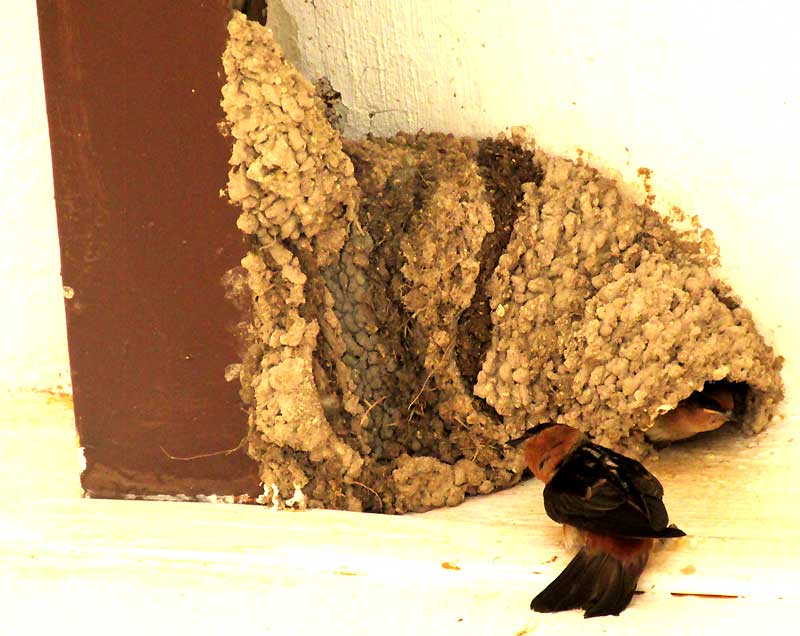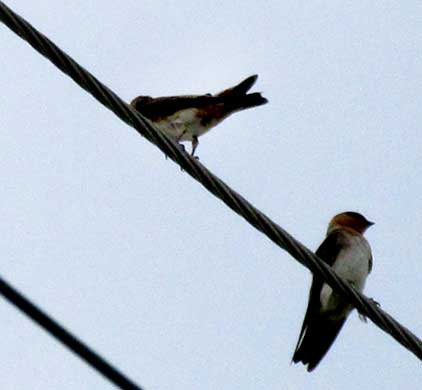Excerpts from Jim Conrad's
Naturalist Newsletter
from the October 13, 2008 Newsletter issued from Yokdzonot, Yucatán, MÉXICO
CAVE SWALLOW
I entered the cenote via a steep, wooden staircase, the air becoming ever more humid. A feeling for the pit is provided by a picture of the opposite wall below:

The dangling items are the rootlike stems, or stemlike roots of strangler fig trees growing at the rim.
About 15 feet from the platform used by swimmers when they slide into the water a single swallow perched on a tiny ledge beneath a shadowy overhang. Using a flash I got the picture of an immature bird shown below:

When I saw the above image I was struck by how similar the species is to the much more widely distributed and common Cliff Swallow. In fact, because of the black belt beneath the throat I thought it might be that species. Cliff Swallows don't breed here but they do migrate southward through here at this time of year, toward their winter homes in Brazil and Argentina.
However, in Howell's A Guide to The Birds of Mexico and Northern Central America I read that juvenile Cave Swallow chests are washed with duskiness, while no such duskiness is mentioned for juvenile Cliff Swallows. Also, folks here tell me that the same large number of swallows is present year round, so at least I know there's no large influx of migrant Cliff Swallows right now. Therefore I'm calling what's in the picture a juvenile Cave Swallow with maybe 95% certainty, and if I'm wrong I know I'll hear about it.
Cave Swallows display an interesting distribution pattern. A population lives permanently in north-central Mexico, during the summer expanding its northern limits into the nearby southwestern US. In far southern Mexico, in Chiapas, a small, isolated population also visits just for the summer. And then here in the upper Yucatán Peninsula we have another isolated but permanent population.
entry dated July 4, 2019, issued from near the forest just west of Tepakán; elev. ~9m (~30 ft), N21.053°, W89.052°; north-central Yucatán state, MÉXICO
CAVE SWALLOW NESTS

The high, white ceiling of the spacious portico of Tepakán's Municipal Palace echoed with bright twittering as I passed by. Numerous swallows flitted back and forth beneath the ceiling, in and out of their mud nests and back and forth from one end of the ceiling to another, a whole community of little birds calling to one another and seeming to fly about just for the fun of it. Adding to the spectacle, just below the level of cavorting swallows the local folks had strung many strings from one side of the portico from another, and from the strings dangled dozens of brightly colored, quadrangular sheets of ornamentally cut paper, a traditional Mexican paper-art handicraft known as papel picado or papel chinacalado. It was like a circus up there.
Each of the ten or so iron crossbeams supporting the roof had at both ends mud swallow-nests like the one shown above.
Eight species of swallows (ten counting martins, which are big swallows) can be seen in the Yucatan. However, only two species display the reddish or buff throats along with squarish tail tips (not deeply forked like Barn Swallows) seen on the birds in our picture, and those two very similar species are the Cliff and Cave Swallows. Cliff Swallows only migrate through the Yucatan, not nesting, so that means that our portico-dwelling birds are Cave Swallows. Howell describes the habitats of Cave Swallows as "towns, cities, open and semiopen aeas," which fits Tepakán's portico exactly.
Watching these birds, I got the impression that they were mostly nestlings at that stage in their lives when they're just learning to fly. Some nestlings seemed content to peep from their nest's hole, like one in the picture above, while others clung to seams, cracks and rough spots on the walls near the nests, like the other bird in the above picture, and yet others would sail from their nest for just a brief circuit below, then quickly return.
from the October 26, 2014 Newsletter issued from Río Lagartos, on the Yucatan Peninsula's northern coast (~N21.60°, ~W88.16°), Yucatán state, MÉXICO
CAVE SWALLOWS ON A WIRE
Eight species of swallows can be seen in our area, so when about fifteen birds turned up perched close together on an electrical wire running along the picturesque street next to Río Lagartos's seawall, the Malecón, I wondered who they might be. You can see a couple below:

An Important field mark to notice is that the birds' tails are only slightly notched, so they're not the Barn Swallows with deeply forked tails the visiting Northerner might expect. Also, despite the silhouetting caused by the bright background, an orangish color can be see on one birds throat, while the other bird displays similar orange color on the bottom near the tail.
These two features narrow down our possibilities to the Cliff and Cave Swallow. Some field guides show Cliff Swallows with squared tails and Cave Swallows with slightly notched ones, but Howell says that the tails of both of those species can range from squared to slightly cleft. The main difference Howell seems to find is that on the upper breast of the Cliff Swallow the orangish throat darkens at its base, strongly contrasting with the whitish underparts, while on Cave Swallows there's no such strong contrast.
Our birds don't seem to have a hint of that dark splotch below the orangish throat, the transition from throat to breast appearing gradual, so that's a vote for their being Cave Swallows. Another vote is that Cave Swallows are permanent residents here and I've often seen them here where they live in sinkholes, locally known as cenotes. However, Cliff Swallows only migrate through the area and I can't recall seeing them.
Still, even Howell admits that, especially in the Yucatan, juveniles of the two species can be confused.